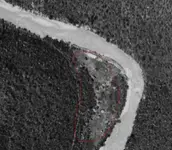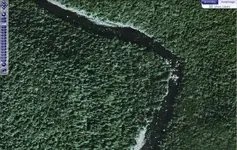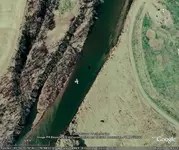I have reviewed down stream bends similar to the spot in question, comparing the erosion and deposition patterns. The place of attention is right at the spot that usually gets a lot of deposits from flooding. Due to the steepness of the walls of the canyon here I tend to discount the idea the river has changed course as other reply has suggested. The immediate angle of the walls might also limit deposits seen in other inside bends, which usually gives them a clean or wiped out appearance. Note that in the newer pictures this area is tree covered. The inference being that _if_ the clearing seen in the older photos was cause by water, why is it now tree covered? Another mystery to me involves why put even a temporary structure in this location? If they are buildings, I have some thoughts on why. First some more info is needed. In the original photos (another thread) there appeared to be a railroad bride and tunnel across the (SW end?) neck of this bend / loop (not shown here). This testifies to the steepness of the terrain, as the older roads usually follow the river. If this is a railroad bridge and tunnel, do you know when it was constructed relative the date of the 1939 photo? If the 1939 photo is covers a larger area, is this bridge and tunnel present? thanks K.






 Since I have never posted a pic here I am going to use this as practice. It is coming into Montoursville Airport. Well that seem easy enough, hope it comes over.
Since I have never posted a pic here I am going to use this as practice. It is coming into Montoursville Airport. Well that seem easy enough, hope it comes over.
